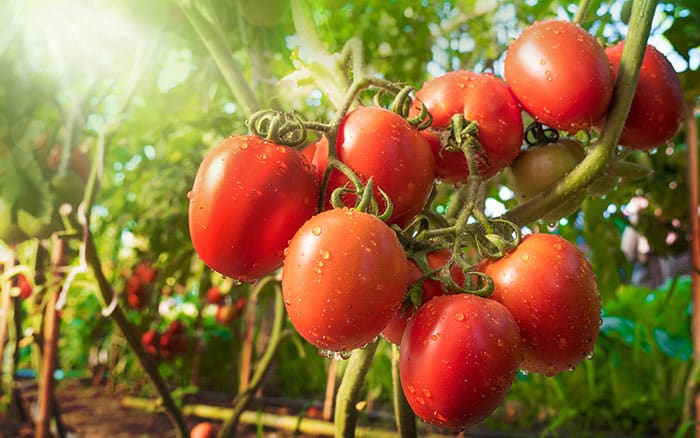As the world’s favourite fruit, tasty tomatoes have a lot to offer.
These beloved berry-red beauties are easy to grow by beginner gardeners and seasoned professionals alike. So, here are my top tips to get your tomato plants producing bountiful crops all season long.
Know the tomato

Growing tomatoes from seed can be really easy and it’s a great way to save money. But if you’ve forgotten to plant tomato seeds in time, never fear – get down to the local garden centre for your pick of ready-grown young plants. Tomatoes come in two basic kinds: vine (or indeterminate) tomatoes can grow up to 6 feet tall and need pruning and support, while bush (or determinate) tomatoes are compact and need little or no support or pruning.
Check labels to find out which you’re looking at. Bush tomatoes are very fuss-free productive plants and are perfect for beginner gardeners.
Toughen up
Whether buying young plants or nurturing your own seedlings, tomatoes should be ready to plant outside into their final positions once they’re producing their first flowers.
Since indoor-grown plants are used to a cushy life of continual warmth and shelter, when it’s time to plant out, it’s best to introduce them to outdoor conditions gradually (‘hardening off’).
To do this, place plants in a sheltered spot outside on a warm day for one hour before returning indoors. Repeat daily for two weeks, slowly lengthening time and exposure to direct sunlight and wind. This will help plants to toughen up before going outside. They will then be ready to fend for themselves overnight as long as night time temperatures stay at 10˚C or above, wherever possible.

Pick the right spot

Tomatoes love a good depth of soil that allows them to put down deep roots.
Planting them into deep vegetable growing bags filled with good quality compost, into compost bags stood upright with a few drainage holes poked into the bottom or into garden borders with lots of compost incorporated are all easy ways to get great results.
If planting more than one, space them around 1.5-2 feet apart so they have ample room to spread.
Plants also need 6-8 hours of sun a day to ripen their fruits to their full potential.
Identify the sun trap in your garden and pop your plants there for plentiful crops of delicious toms with maximum flavour.
Lean on me
When tomatoes grow the fruits get heavy, so supporting the plant keeps them healthy. If you place supports around them as you plant out, you’ll get all the benefits without disturbing plant roots.
For upright bush tomatoes, simply secure loosely to a 3-foot bamboo cane using garden string or reusable plastic plant clips.
Vine tomatoes need a little more TLC than this. One way to support them is to fasten their central stem to a 6-8 foot bamboo cane, adding new ties as each new set of leaves forms. A slightly more expensive, but excellent modern alternative is to use a tomato ladder. This is a set of steel rungs that slot together to form an ever-extending support that holds the central stem upright and supports side shoots as they crop without the need for fastening.

Get plucky

Since vine tomatoes produce most of their fruit on their central stem, pinching out ‘suckers’ (additional branches that grow between the leaves and stem) will give you a bigger crop.
This focuses the plant’s energy on producing and ripening fruit instead of growing more foliage, which can get out of control.
Be careful, though, as bush tomato side shoots are valuable tomato-producing branches! Leaving them in place on bush varieties will give you a bigger harvest.
Hungry and thirsty
Tomatoes are 95% water, meaning that plants need a constant supply to produce top quality fruits. If you’ve ever had your tomatoes split on the vine, this is usually due to fluctuating water levels – dehydrated plants form a hard skin on developing fruits and this splits when water is available again and fruits suddenly expand.
Problems like this are easily solved by watering your plants regularly, ensuring soil stays moist but doesn’t become waterlogged. Plants grown in hanging baskets and containers, which have a greater surface area, dry out much faster and will need more regular watering than those grown in the ground.
Fruiting tomatoes also require a regular supply of high potash fertiliser, which helps them to form fruit.
Choosing one of the many fertilisers designed specifically for tomatoes and feeding from the moment your plants start producing flowers will keep your plants producing top quality fruits.

Tip:
Male cucumber flowers,
without a swelling at the base,
produce blossoms but no fruit—these flowers
can be deep fried and eaten.
Follow these top growing tips and you’ll be rewarded with heavy trusses of ripe tomatoes for months to come—perfect for eating fresh off the vine, sprinkling with salt and oregano, with a slice of cheese for a delicious daytime delight!
Happy gardening everyone!
Reader questions
Can I get a second crop of leaves from my greens?

For ‘cut and come again’ spring greens, cut the leaves just at their base to leave a stump when harvesting, starting with older outer leaves and working inwards.
When you have cut all of the leaves, cut a cross in the top of the stalk and new growth will emerge.
How do I stop greenfly attacking my roses?

Greenfly are common garden pests which suck sap from a plant and weaken its growth. They are usually found in clusters on young shoots. Get rid of them by filling a spray bottle with a solution of washing up liquid and water, which coats the insect with detergent and eliminates them.

Leave A Comment